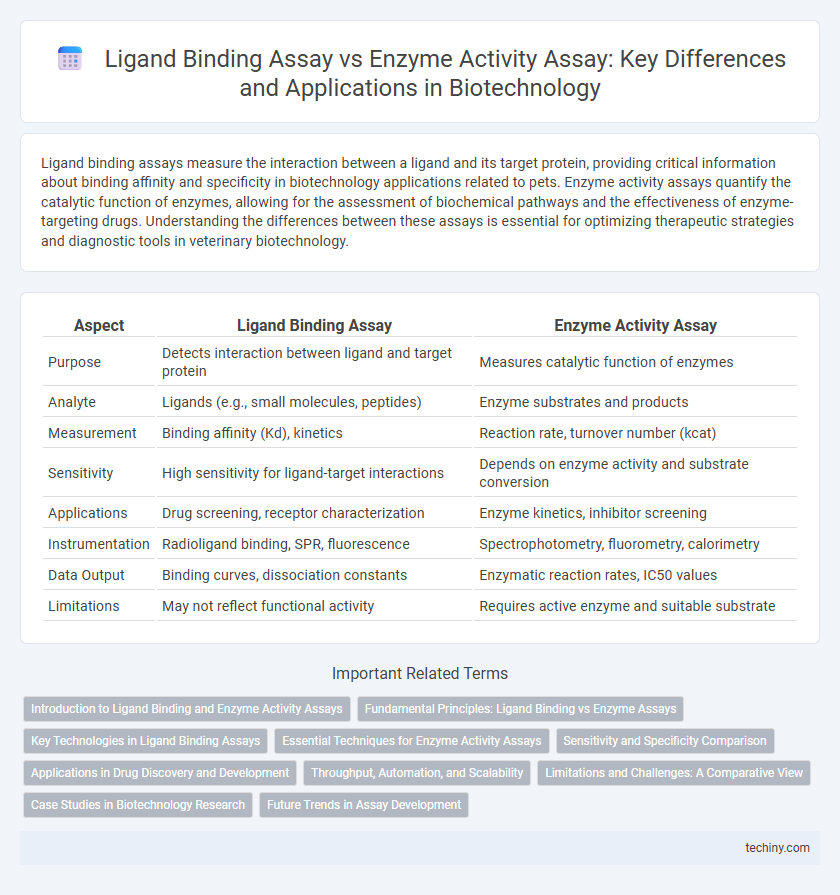Ligand binding assays measure the interaction between a ligand and its target protein, providing critical information about binding affinity and specificity in biotechnology applications related to pets. Enzyme activity assays quantify the catalytic function of enzymes, allowing for the assessment of biochemical pathways and the effectiveness of enzyme-targeting drugs. Understanding the differences between these assays is essential for optimizing therapeutic strategies and diagnostic tools in veterinary biotechnology.
Table of Comparison
| Aspect | Ligand Binding Assay | Enzyme Activity Assay |
|---|---|---|
| Purpose | Detects interaction between ligand and target protein | Measures catalytic function of enzymes |
| Analyte | Ligands (e.g., small molecules, peptides) | Enzyme substrates and products |
| Measurement | Binding affinity (Kd), kinetics | Reaction rate, turnover number (kcat) |
| Sensitivity | High sensitivity for ligand-target interactions | Depends on enzyme activity and substrate conversion |
| Applications | Drug screening, receptor characterization | Enzyme kinetics, inhibitor screening |
| Instrumentation | Radioligand binding, SPR, fluorescence | Spectrophotometry, fluorometry, calorimetry |
| Data Output | Binding curves, dissociation constants | Enzymatic reaction rates, IC50 values |
| Limitations | May not reflect functional activity | Requires active enzyme and suitable substrate |
Introduction to Ligand Binding and Enzyme Activity Assays
Ligand binding assays quantify the interaction between a ligand and its target biomolecule, providing insights into receptor affinity, specificity, and kinetics by measuring binding constants such as Kd and Bmax. Enzyme activity assays evaluate catalytic function by quantifying substrate conversion rates, enzyme kinetics parameters like Vmax and Km, and the impact of inhibitors or activators on enzymatic reactions. Both assays are fundamental in drug discovery and biochemical research, enabling characterization of molecular interactions and enzymatic function critical for therapeutic targeting.
Fundamental Principles: Ligand Binding vs Enzyme Assays
Ligand binding assays measure the interaction between a ligand and a specific protein, quantifying the affinity and kinetics of binding events without requiring enzymatic activity. Enzyme activity assays detect the catalytic function of enzymes by monitoring the conversion rate of substrates into products, providing insights into enzyme kinetics, inhibition, and mechanism. While ligand binding assays focus on molecular recognition and affinity, enzyme activity assays emphasize functional output and catalytic efficiency.
Key Technologies in Ligand Binding Assays
Ligand binding assays utilize technologies like surface plasmon resonance, fluorescence polarization, and radio-ligand binding to measure the interaction between ligands and target proteins with high specificity and sensitivity. These assays are essential for quantifying binding kinetics, affinity constants, and receptor occupancy, providing critical insights into drug-receptor interactions. Enzyme activity assays, by contrast, focus on measuring catalytic function and substrate conversion rates rather than direct binding events.
Essential Techniques for Enzyme Activity Assays
Ligand binding assays measure the interaction between a ligand and its target protein, providing insights into binding affinity and kinetics, while enzyme activity assays quantify the catalytic function of enzymes by monitoring substrate conversion rates. Essential techniques for enzyme activity assays include spectrophotometric methods, fluorometric detection, and coupled enzymatic reactions, which enable precise measurement of reaction velocity and enzyme kinetics. These assays are crucial for drug discovery, enzyme characterization, and understanding biochemical pathways at a molecular level.
Sensitivity and Specificity Comparison
Ligand binding assays exhibit higher sensitivity by detecting low concentrations of target molecules through specific receptor-ligand interactions, making them ideal for early-stage biomarker identification. Enzyme activity assays demonstrate superior specificity by measuring the catalytic function of enzymes, providing precise insights into enzymatic mechanisms and substrate interactions. Sensitivity in ligand binding assays enables detection of subtle molecular changes, whereas enzyme activity assays deliver detailed functional specificity crucial for biochemical pathway analysis.
Applications in Drug Discovery and Development
Ligand binding assays are crucial for identifying drug-receptor interactions by quantifying the affinity and specificity of potential therapeutic compounds, facilitating target validation in early drug discovery. Enzyme activity assays measure catalytic function and inhibition effects, enabling the evaluation of drug efficacy, mechanism of action, and toxicity during lead optimization and preclinical development. Both assays complement each other by providing comprehensive biochemical characterization necessary for optimizing drug candidates and accelerating the development pipeline.
Throughput, Automation, and Scalability
Ligand binding assays typically offer high throughput capabilities with well-established automation protocols, enabling rapid screening of large compound libraries. Enzyme activity assays vary in throughput depending on substrate complexity but often require more intricate detection steps, limiting scalability compared to ligand binding assays. Both assay types can be adapted for automated platforms; however, ligand binding assays generally provide greater scalability for high-throughput drug discovery workflows in biotechnology.
Limitations and Challenges: A Comparative View
Ligand binding assays often face limitations such as low specificity and interference from non-specific binding, complicating data interpretation in complex biological matrices. Enzyme activity assays can suffer from challenges related to substrate availability and instability, as well as difficulties in distinguishing between isozyme activities. Both assay types require careful optimization to address issues of sensitivity, reproducibility, and assay conditions that impact accuracy and reliability in biotechnological research.
Case Studies in Biotechnology Research
Ligand binding assays measure the specific interaction between a ligand and its target protein, providing critical insights into receptor-ligand affinity and kinetics, which is essential in drug discovery studies such as G-protein-coupled receptor (GPCR) targeting. Enzyme activity assays quantify catalytic function by monitoring substrate conversion rates, as demonstrated in case studies involving enzyme inhibition in metabolic pathway engineering. Comparative analyses in biotechnology research reveal ligand binding assays excel in characterizing molecular interactions, while enzyme activity assays are pivotal for assessing functional enzyme modulation in therapeutic development.
Future Trends in Assay Development
Future trends in assay development emphasize increasing sensitivity and specificity in both ligand binding assays and enzyme activity assays through advanced technologies like microfluidics and biosensors. Integration of artificial intelligence and machine learning enhances data analysis, enabling high-throughput screening and more precise kinetic measurements. Multiplexing capabilities and miniaturization foster more cost-effective and rapid diagnostics, driving personalized medicine and drug discovery advancements.
Ligand binding assay vs Enzyme activity assay Infographic

 techiny.com
techiny.com